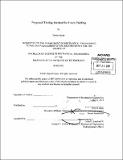Proposed testing method for foam padding
Author(s)
Hyatt, Daniel (Daniel Elliot)
DownloadFull printable version (5.011Mb)
Other Contributors
Massachusetts Institute of Technology. Dept. of Mechanical Engineering.
Advisor
Kim B. Blair.
Terms of use
Metadata
Show full item recordAbstract
One very basic necessity for foam padding testing technology is the ability to test two different padding samples and compare the results. The current standard for testing is to use a steel anvil backing for the padding, create an impact and record the parameters of the collision. The standardized method of testing with a steel anvil backing may not truly depict which foam or padding is actually the most protective, and this project aims to demonstrate how using a more humanlike backing produces more accurate test results. The experimentation setup used a projectile shot with a known velocity at various padding samples, where both a steel anvil and urethane foam are used as separate backings for the experiment. The steel anvil represents the current industry testing standard, whereas the urethane foam is meant to physically replicate the characteristics of human flesh. Using a load cell which is calibrated with an oscilloscope, a curve of the force applied over time will be recorded for each test run. From this force curve, the peak force, total impulse, and energy dissipated were calculated for each collision. By comparing these metrics across different foam padding specimens using the two padding backings across different velocities, the effect of varying the padding backing are demonstrated in the experimental results. Although using the steel anvil backing lead to generally similar recommendations for the best padding, it does not capture a lot of the details which are necessary to truly understand how different foam specimens compare with each other. Two main conclusions are drawn regarding the difference between the steel anvil and urethane foam setups: the difference in the shape of the force over time curves and the significance of changing the velocity of the impact. Using the urethane foam backing also established two different regimes which define whether or not the padding user would feel a significant impact. The parameters of these regimes provide the best data for deciding on appropriate foam specimens. The steel anvil backing lacks any capacity to test or predict which impacts are severe enough to cause serious injury.
Description
Thesis (S.B.)--Massachusetts Institute of Technology, Dept. of Mechanical Engineering, 2011. Cataloged from PDF version of thesis. Includes bibliographical references (p. 31).
Date issued
2011Department
Massachusetts Institute of Technology. Department of Mechanical EngineeringPublisher
Massachusetts Institute of Technology
Keywords
Mechanical Engineering.